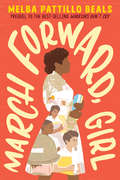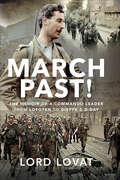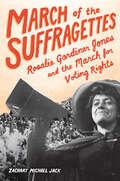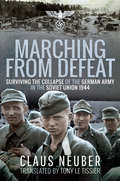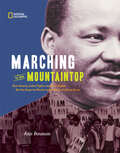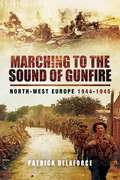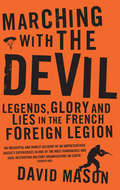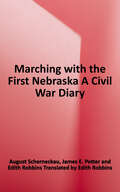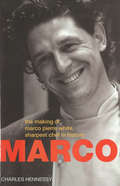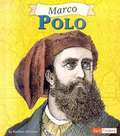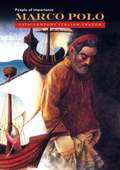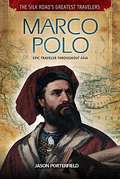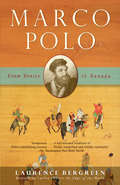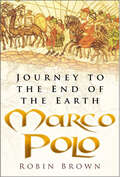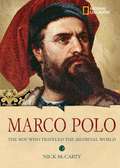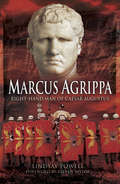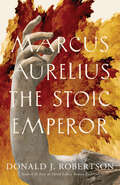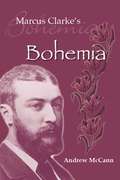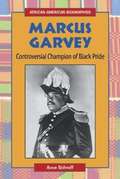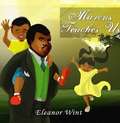- Table View
- List View
March Forward, Girl: From Young Warrior to Little Rock Nine
by Melba Pattillo Beals Frank MorrisonFrom the legendary civil rights activist and author of the million-copy selling Warriors Don't Cry comes an ardent and profound childhood memoir of growing up while facing adversity in the Jim Crow South. Long before she was one of the Little Rock Nine, Melba Pattillo Beals was a warrior. Frustrated by the laws that kept African-Americans separate but very much unequal to whites, she had questions. Why couldn’t she drink from a "whites only" fountain? Why couldn’t she feel safe beyond home—or even within the walls of church? Adults all told her: Hold your tongue. Be patient. Know your place. But Beals had the heart of a fighter—and the knowledge that her true place was a free one. Combined with emotive drawings and photos, this memoir paints a vivid picture of Beals’ powerful early journey on the road to becoming a champion for equal rights, an acclaimed journalist, a best-selling author, and the recipient of this country’s highest recognition, the Congressional Gold Medal.
March Past: The Memoir of a Commando Leader, From Lofoten to Dieppe & D-Day
by Lord LovatAt the outbreak of war in 1940, Simon Frazer, the 15th Lord Lovat and a former Guards officer, was mobilized from the reserve list to join the Lovat Scouts, the British Army’s first sniper unit that had been formed by his father during the Boer War. The following year he volunteered for one of the new Commando units then being created. Lovat was personally involved in the training of the Commando troops on the West coast of Scotland. He was eventually attached to, and led, No.4 Commando. On 3 March 1941, Nos. 3 and 4 Commando launched a raid on the German-occupied Lofoten Islands. In this successful attack, Operation Claymore, the commandos destroyed fish-oil factories, petrol dumps, and even eleven ships. They also seized encryption equipment and codebooks, as well as captured 216 German troops. Promoted to temporary major, Lovat led 100 men of No.4 Commando and a 50-man detachment from the Canadian Carleton and York Regiment in a raid on the French coastal village of Hardelot in April 1942. For this action he was awarded the Military Cross on 7 July that year. Lord Lovat was involved in further raids against the German-held French coast, most notably Dieppe, during which No.4 Commando destroyed the coastal battery at Varengeville-sur-Mer in a textbook commando attack. This resulted in Lovat being awarded the DSO. Such was the effect the Commando raids had on German morale, Lovat had 100,000 Reichmarks placed on his head, dead or alive. Promoted to brigadier, Lovat formed the 1st Special Service Brigade (later the 1st Commando Brigade) which stormed ashore on D-Day to secure the eastern flank of the attacking forces. In this, he famously instructed his personal piper, Bill Millin, to pipe the commandos and himself ashore, in defiance of specific orders not to allow such an action in battle. In the subsequent fighting Lovat was seriously wounded, effectively ending his active career. These are the memoirs of one of the most remarkable fighting figures of the Second World War, who was involved in some its more exciting and dangerous operations. Despite his aristocratic ancestry, he led from the front and, without doubt, Simon Frazer, Lord Lovat was a soldiers’ soldier.
March of the Suffragettes: Rosalie Gardiner Jones and the March for Voting Rights
by Zachary Michael JackMarch of the Suffragettes tells the forgotten, real-life story of "General" Rosalie Gardiner Jones, who in the waning days of 1912 mustered and marched an all-women army nearly 200 miles to help win support for votes for women. General Jones, along with her good friends and accomplices "Colonel" Ida Craft, "Surgeon General" Lavinia Dock, and "War Correspondent" Jessie Hardy Stubbs, led marchers across New York state for their pilgrims' cause, encountering not just wind, fog, sleet, snow, mud, and ice along their unpaved way, but also hecklers, escaped convicts, scandal-plagued industrialists on the lam, and jealous boyfriends and overprotective mothers hoping to convince the suffragettes to abandon their dangerous project. By night Rosalie's army met and mingled with the rich and famous, attending glamorous balls in beautiful dresses to deliver fiery speeches; by day they fought blisters and bone-chilling cold, debated bitter anti-suffragists, and dodged wayward bullets and pyrotechnics meant to intimidate them. They composed and sang their own marching songs for sisterhood and solidarity on their route, even as differences among them threatened to tear them apart. March of the Suffragettes chronicles the journey of four friends across dangerous terrain in support of a timeless cause, and it offers a hopeful reminder that social change is achieved one difficult, dauntless, daring step at a time.
Marching Along: Recollections of Men, Women and Music
by John Philip Sousa Paul E. BierleyMarching Along is the intriguing autobiography John Philip Sousa wrote in the final years of his life. Sousa (1854-1932) was America's first superstar, a giant of his day. He conducted more than 14,000 concerts, composed a hundred hit tunes, and wrote three Broadway musicals that ran at the same time. In 1900 he was the best-known musician in the world, friends with presidents, corporate giants, and movie stars. Marching Along contains the amusing and insightful reflections of a world-class musician who charmed audiences around the globe for half a century yet also reveals the man's humble nature as a simple lover of music. This book brings the colorful story of the March King and his music into true focus in an engaging and entertaining way. It is sure to bring every reader, musician or not, insights into the man who dominated the musical scene of early twentieth-century America.
Marching from Defeat: Surviving the Collapse of the German Army in the Soviet Union 1944
by Claus NeuberIn this WWII memoir, a Nazi soldier recounts his desperate retreat from Russia, offering rare insight into the collapse of Hitler’s Army Group Central.In June of 1944, the Red Army launched a massive offensive that crushed Hitler’s forces in Belarus. German soldiers who weren’t captured had to fight their way back towards their own lines across hundreds of miles of enemy territory. This is the story of one of them, Claus Neuber, a young artillery officer who describes in graphic detail his experiences during that great retreat.Neuber’s account carries the reader through the desperate defensive battles and rearguard actions fought to stem the relentless Soviet advance and breakout from the cauldrons between Minsk and the Beresina river. After almost seventy days as a fugitive, depending on the kindness of villagers, enduring extremes of cold, wet and hunger, Neuber found his way back to the German lines. This personal narrative, translated for the first time from the original German, gives a dramatic insight into the impact of the Soviet offensive and the disintegration of an entire German army. It vividly records in day-to-day detail the experience of such a bitter defeat.
Marching to Freedom: The Story of Martin Luther King, Jr. (Famous Lives)
by Joyce MiltonA biography of the Baptist minister and civil rights leader whose practice of nonviolent civil disobedience helped African Americans win many battles for equal rights.
Marching to the Drums: Eyewitness Accounts of War from the Kabul Massacre to the Siege of Mafeking
by Ian KnightIn this gripping collection of first-hand accounts, Ian Knight presents the adventure of nineteenth-century warfare from the thrill of the cavalry charges at Balaklava and Omdurman, to the terror of battle against an overwhelming odds such as Rorke's Drift in the words of the men actually there.These eyewitness accounts provide a vivid and sometimes shocking insight into the brutal realities of warfare for the British imperial soldier, who fought against enemies from massed ranks of Russians and assegai-armed natives to sharp-shooting Boers, in often the most terrible conditions imaginable.These stirring tales of military adventure have been edited by Ian Knight and brought together and published in book form. Originally featured in turn-of-the-century magazine, popular during the heyday of empire, these historically valuable accounts throw considerable light on campaign conditions during Queen Victoria's colonial wars.Marching to the Drums includes accounts focusing on the experience of battle during such pivotal conflicts as the Sikh Wars, the Crimean War, the Afghan Wars, the Anglo-Zulu War, and those in China, the Sudan and South Africa.
Marching to the Mountaintop: How Poverty, Labor Fights and Civil Rights Set the Stage for Martin Luther King Jr's Final Hours
by Ann BausumIn early 1968 the grisly on-the-job deaths of two African-American sanitation workers in Memphis, Tennessee, prompted an extended strike by that city's segregated force of trash collectors. Workers sought union protection, higher wages, improved safety, and the integration of their work force. Their work stoppage became a part of the larger civil rights movement and drew an impressive array of national movement leaders to Memphis, including, on more than one occasion, Dr. Martin Luther King, Jr.King added his voice to the struggle in what became the final speech of his life. His assassination in Memphis on April 4 not only sparked protests and violence throughout America; it helped force the acceptance of worker demands in Memphis. The sanitation strike ended eight days after King's death.The connection between the Memphis sanitation strike and King's death has not received the emphasis it deserves, especially for younger readers. Marching to the Mountaintop explores how the media, politics, the Civil Rights Movement, and labor protests all converged to set the scene for one of King's greatest speeches and for his tragic death.National Geographic supports K-12 educators with ELA Common Core Resources.Visit www.natgeoed.org/commoncore for more information.
Marching to the Sound of Gunfire: North-West Europe, 1944–1945
by Patrick DelaforceIn this exciting and revealing book, scores of British soldiers tell their amazing stories of life and death in the front line of the Allies' advance from Normandy to Hitler's Germany. In eleven months of bitter fighting between D-Day and VE Day the combined efforts of the British and their allies' armed forces ground down their ruthless enemy in the pursuit of victory. Each and every man has a unique story to tell, whether they were infantry, tank crews, gunners, sappers or in vital logistic and supporting units. Theirexperiences make for powerful and fascinating reading. First-hand accounts of the landings, liberation of towns and villages, fierce actions, not all successful, bring home to the reader the cost of war as well as the magnitude of the venture. Particularly evocative is the range of emotions that were experienced by those involved, be they generals or the most junior soldiers. The passage of time means that many of these 'voices' will be heard no more but fortunately Marching to the Sound of Gunfire captures their inspiring testimonies for posterity.
Marching with the Devil: Legends, Glory and Lies in the French Foreign Legion
by David Mason`Since its creation in 1831, the French Foreign Legion has become the stuff of myth, fiction and dreams... Anyone thinking of joining up would be well advised to read this book first? - The Sun HeraldA real-life boy's own adventure, Marching With The Devil is an account of David Mason's five years in the infamous French Foreign Legion.David Mason graduated from the Australian National University with a law degree and an honours degree. Like those around him, he could easily have settled for a life of share portfolios, good suits, new cars and big houses. But David wanted more ? he wanted a challenge, an adventure, something beyond the ordinary that would test him physically and mentally. He looked around to see what he could do. Working in an open-cut mine . . . done that. Running a marathon . . . hmm, not hard enough. Climbing Everest . . . maybe? Joining the French Foreign Legion . . . perfect!Marching With The Devil is the gripping true story of what happened when an Australian lawyer left his comfortable existence and joined the legendary French Foreign Legion. He stayed for five years and served time in the elite Parachute Regiments. With the motto 'March or Die', the legion has a history of pain, grief and glory. David Mason takes us behind the myth to reveal exactly what happens: the adventure, the danger, the drinking, the fighting and the lies that sustain the legend.fore the final choice must be made.`Remarkable... It's hard not to think it a shame that a man of such obvious gifts should have wasted them on the legion, just so as not to have to feel like a quitter, even if this book was the result? - The Age`Marching with the Devil quickly turns into an insightful and honest account of an unpretentious Aussie's experiences in one of the most ramshackle and soul-destroying military organisations on Earth? - Courier Mail`A strangely compulsive read about one man?s quest for self knowledge? - Men's Health Magazine`Mason left a comfortable life in Australia to test himself in the crucible of the legion, and he writes about it 20 years after his service time necessary to give himself the distance and context he needed to write about an extraordinary and painful experience? - Sunday Mail Brisbane
Marching with the First Nebraska: A Civil War Diary
by August ScherneckauAugust Scherneckau’s diary is the most important firsthand account of the Civil War by a Nebraska soldier that has yet come to light. A German immigrant, Scherneckau served with the First Nebraska Volunteers from 1862 through 1865. Depicting the unit’s service in Missouri, Arkansas, and Nebraska Territory, he offers detail, insight, and literary quality matched by few other accounts of the Civil War in the West. His observations provide new perspective on campaigns, military strategy, leadership, politics, ethnicity, emancipation, and a host of other topics. Scherneckau takes readers on the march as he and his comrades plod through mud and snow during a grueling winter campaign in the Missouri Ozarks. He served as a provost guard in St. Louis, where he helped save a former slave from kidnappers and observed the construction of Union gunboats. He describes the process of transforming a regiment from infantry to cavalry, and his account of First Nebraska’s pursuit of Freeman’s Partisans in Arkansas is an exciting portrayal of mountain fighting. An annotated edition that brings to bear the editors’ and translator’s respective expertise in both the Civil War and the German language, Scherneckau’s account is an important addition to primary material on the war’s forgotten theater. It will be a valued resource for historian and Civil War enthusiast alike.
Marcia Clark: Her Private Trials and Public Triumphs
by Clifford L. LinedeckerWife. Mother. Celebrity. Crusader. Who is the real Marcia Clark? How did a sheltered, studious young woman born into a religious Jewish family become a hard-hitting prosecutor and National media star? Read about: Her early childhood in san Francisco-- and dreams of the stage. Her stormy first marriage to a high-stakes gambler whose rip-off victims included O.J. Simpson ... Her Meteoric rise from defense attorney to Special Trials Prosecutor whose high-profile cases included the Rebecca Schaeffer stalker murder trial. Her past battles with Robert Shapiro. The man who was her secret mentor. Her disastrous second marriage-- and the custody battle for their two young sons that has sparked outrage across America. Why she underwent a complete makeover for the O.J. Simpson case.
Marco Pierre White: Making of Marco Pierre White,Sharpest Chef in History
by Charles HennessyMarco was born of working-class parents on a bleak council estate in Leeds, and his Italian mother died when he was six years old. Today he has become a star chef of international renown, a controversial media celebrity, a national icon of the 1980s and 1990s, and a multimillionaire entrepreneur - all before the age of 40. How has this staggering rise to fame and fortune been achieved? MPW (as he calls himself and many of his new restaurants) is today widely regarded as the best cook in the country, but his astonishing talents and understanding of food are only part of the explanation. As this fascinating book reveals, there are many sides to this complex man which the massive media coverage he has received over the years have never revealed. Charles Hennessy tells the story with insight: the unpromising early life, his first job as a kitchen porter in Harrogate, the epiphany at the age of 17 when he went to work at the Box Tree restaurant in Ilkley, his arrival in London, learning under the Roux brothers, Pierre Koffmann and Raymond Blanc, and the opening of his own first restaurant, Harvey's from whence his fame and fortune grew.
Marco Polo (Fact Finders Biographies)
by Kathleen McFarrenProvides an introduction to the life of the thirteenth-century Venetian explorer Marco Polo who traveled along the Silk Road to the court of Kublai Khan in China.
Marco Polo: 13th-Century Italian Trader
by John RiddleTrader Marco Polo was one of the first Europeans to travel to China, staying away from his homeland in Italy for 24 years before returning. After he came back to Italy, Marco wrote of his travels and adventures in East Asia in his book Il Milione, sharing his tales with other Europeans. Polo changed the way Europeans saw the world by opening their eyes to the wonderful culture and people of China. Learn the story of one of the world's most famous explorers and traders in Marco Polo: 13th-Century Italian Trader.
Marco Polo: Epic Traveler Throughout Asia (The Silk Road's Greatest Travelers)
by Jason PorterfieldUpon returning to his native Venice from a nearly 25-year journey through Asia, Marco Polo fueled the Western imagination with his tales about the splendors of the East. This lively biography follows Marco’s intrepid family as they navigate the spice stalls, caravansaries, and dangers that once populated the Silk Road and enter Kublai Khan’s Mongol court in China, where they served as advisors. Readers will learn about the Polos’ importance as cultural emissaries at a time of limited global exchange and how Marco’s account of their travels—whether fact or fiction—heralded the later golden age of exploration.
Marco Polo: From Venice to Xanadu
by Laurence BergreenBetween 1271 and 1275, Marco Polo, gentleman and merchant of Venice, accompanied his father Niccolo and uncle Maffeo on a journey east from Acre, Israel, into central Asia along the Silk Route, eventually reaching China and the court of the Great Khan of the Mongol Empire, Kublai Khan. Entering the service of the Khan, he travelled extensively in the Mongol Empire. The three Venetians returned home by sea in 1292-5, calling at Sumatra and southern India before reaching Persia and making the last part of their journey to Venice overland.
Marco Polo: Journey to the End of the Earth
by Robin BrownThe incredible story of Marco Polo's journey to the ends of the earth has for the last seven hundred years been beset by doubts as to its authenticity. Did this intrepid Venetian really trek across Asia minor as a teenager, explore the length and breadth of China as the ambassador of the ruthless dictator, Kublai Khan, and make his escape from almost certain death at the hands of Kublai Khan's successors? Robin Brown's book aims to get to the truth of Marco Polo's claims. Covering his early life, his extraordinary twenty-four-year Asian epic and his reception in Italy on his return, 'Marco Polo' places the intrepid Venetian in context, historically and geographically. What emerges confirms the truth of Polo's account. Polo, scholars now agree, opened vistas to the medieval mind and stirred the interest in exploration that prompted the age of the European ocean voyages. All who now enjoy the fruits of Marco Polo's incredible journey through Asia - whether in the form of spectacles, fireworks, pasta or any of the many products of the Silk Road - will find in Robin Brown's book a fascinating portrait of a man who made history happen by bringing about the meeting of East and West.
Marco Polo: The Boy Who Traveled the Medieval World (National Geographic World History Biographies)
by Nick McCarty<p>In a life of ceaseless exploration, Marco Polo pushed out the borders of his narrow medieval world. <p>Born in Venice in 1254, the young Marco Polo first met his father at age 15, when the elder Polo returned from a trading expedition to the East. The father's tales of the court of the Kublai Khan in China ignited a lifelong passion for adventure in the son. <p>The Polos set out for China in 1271, traveling through the Middle East, across the Gobi Desert, to Khanbaliq in China. The journey took four years. Kublai Khan took a great liking to Marco Polo, employing him as a spy throughout his vast empire. Marco traveled and observed the cultures of Sumatra, Sri Lanka, and India in this capacity. His notes later became one of the world's great travel books, The Description of the World.</p>
Marcus Agrippa: Right-Hand Man of Caesar Augustus
by Lindsay PowellThe authoritative biography of the ancient Roman general and loyal deputy to Emperor Augustus by the acclaimed historian and author of Augustus at War. When Gaius Octavius became the first emperor of Rome, Marcus Agrippa was by his side. As the emperor&’s loyal deputy, he waged wars, pacified provinces, beautified Rome, and played a crucial role in establishing the Pax Romana—but he always served knowing that he would never rule in his own name. Why he did so, and never grasped power for himself, has perplexed historians for centuries. In this authoritative biography, historian Lindsay Powell offers a penetrating new assessment of Agrippa&’s life and achievements. Following Caesar&’s assassination, Agrippa was instrumental in asserting the rights of his friend Gaius Octavius as the dictator&’s heir, seeing him crowned Emperor Augustus. Agrippa then established a reputation as a bold admiral, defeating Marcus Antonius and Queen Cleopatra at the Battle of Actium, and ending bloody rebellions in the Cimmerian Bosporus, Gaul, Hispania, and Illyricum. Agrippa was also an influential statesman and architect. He established the vital road network that turned Julius Caesar&’s conquests into viable provinces, overhauled Rome&’s drains and aqueducts, and built the original Pantheon. Marrying Augustus&’s daughter, Julia the Elder, Agrippa became co-ruler of the Roman Empire until his death in 12 BC. His bloodline lived on in the imperial family, through Agrippina the Elder, his grandson Caligula, and great-grandson Nero.
Marcus Aurelius: The Stoic Emperor (Ancient Lives)
by Donald J. RobertsonExperience the world of Roman emperor Marcus Aurelius and the tremendous challenges he faced and overcame with the help of Stoic philosophy This novel biography brings Marcus Aurelius (121–180 CE) to life for a new generation of readers by exploring the emperor&’s fascinating psychological journey. Donald J. Robertson examines Marcus&’s relationships with key figures in his life, such as his mother, Domitia Lucilla, and the emperor Hadrian, as well as his Stoic tutors. He draws extensively on Marcus&’s own Meditations and correspondence, and he examines the emperor&’s actions as detailed in the Augustan History and other ancient texts. Marcus Aurelius struggled to reconcile his philosophy and moral values with the political pressures he faced as emperor at the height of Roman power. Robertson examines Marcus&’s attitude toward slavery and the moral dilemma posed by capturing enemies in warfare; his attitude toward women; the role of Stoicism in shaping his response to the threat of civil war; the treatment of Christians under his rule; and the naming of his notorious son Commodus as his successor. Throughout, the Meditations is used to shed light on the mind of the emperor—his character, values, and motives—as Robertson skillfully weaves together Marcus&’s inner journey as a philosopher with the outer events of his life as a Roman emperor.
Marcus Clarke's Bohemia: Literature And Modernity In Colonial Melbourne
by Andrew McCannMarcus Clarke's Bohemia is the first major critical study of Marcus Clarke; arguably Australia's best known and most important nineteenth-century writer. It situates Clarke both within the bohemian culture of Melbourne and a burgeoning cosmopolitan print-culture extending beyond national borders. Marcus Clarke's Bohemia offers detailed readings of Clarke's major works, many of which have not previously been discussed, and traces the influence of other European writers on Clarke's writing. Importantly, it focuses on his engagement with the modernity of the place and time in which he worked and lived. McCann's in-depth study unearths the richness of Clarke's writing and brings nineteenth-century Melbourne to life. Impeccably researched and gracefully written, Marcus Clarke's Bohemia is challenging and compelling reading.
Marcus Furius Camillus: The Life of Rome's Second Founder
by Marc HydenThis is the only modern biography of Marcus Furius Camillus currently available in English. Camillus served as a censor, was elected to six consular tribuneships, appointed dictator five times, and enjoyed four triumphs. He toppled mighty Veii, ejected the Senones from Rome following its sacking, and helped orchestrate a grand compromise between the patricians and plebeians. The Romans even considered him Rome’s second founder – a proud appellation for any Roman – and revered him for being an exemplar of Roman virtue. Interestingly, he never held the consulship. Plutarch stated that Camillus had avoided it on purpose, and for good reason. The office was often at the heart of controversy, given that patricians dominated it for most of Camillus’ life. The appointment of a dictator was an emergency measure taken only in the direst of situations and the fact that Camillus was repeatedly appointed speaks of a period when the young Republic was surrounded by enemies and still fighting for survival. Without Camillus’ efforts the city may never have fulfilled its great destiny. Marc Hyden sifts the fragmentary and contradictory sources and, while acknowledging that much legend and exaggeration quickly accrued around Camillus’ name, presents the story of this remarkable life as the ancient Romans knew it.
Marcus Garvey: Controversial Champion of Black Pride
by Anne SchraffChronicles the life of Marcus Garvey, a fiery black leader who began a crusade for African Americans to fight against oppression in the early years of the twentieth century.
Marcus Teaches Us
by Eleanor Wint<p>Marcus Teaches Us is the first and only book of its kind. It portrays the teachings of The Hon. Marcus Mosiah Garvey in language and pictures that all kids will love. It is bright with innovative colouring activities, uses simple language and gives children the opportunity to practice cursive writing. Marcus Garvey is a monumental, internationally acclaimed Black philosopher who has influenced the independence movement of every black nation in the world. Children worldwide should each have their own copy as they deserve to have the knowledge captured in this attractive book on Marcus Garvey.</p> <P><P><i>Advisory: Bookshare has learned that this book offers only partial accessibility. We have kept it in the collection because it is useful for some of our members. To explore further access options with us, please contact us through the Book Quality link. Benetech is actively working on projects to improve accessibility issues such as these.</i>
